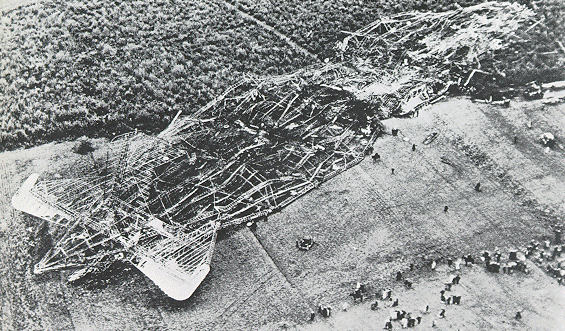|
Nebakenezzer posted:You know what could help you there? Yeah, airships in a forest fire environment would totally work.
|
|
|
|

|
| # ? May 21, 2024 05:46 |
|
Charles posted:Oh yeah I guess it's a lacquer, but I mean, do they actually fly any of them like that besides the 737? The rest are built in the same place as the paint shop I think. The 737 has to make it from Renton to Everett though. https://www.thedrive.com/the-war-zone/34084/the-mysterious-case-of-the-air-forces-new-strangely-modified-737 Pedantic, but zinc chromate is a non-paint coating. It’s really, really nasty poo poo, but it’s exceedingly good at what it does. (Corrosion inhibition.)
|
|
|
|
Nebakenezzer posted:You know what could help you there?   BalloonFish fucked around with this message at 13:14 on Sep 19, 2020 |
|
|
|
Swiggity swooty, gotta burn that balloony
|
|
|
|
https://www.youtube.com/watch?v=e21ZjwZGjiQ
|
|
|
|
Midjack posted:Yeah, SW had a guy get sucked out a window and painted the side of the plane. She was a woman
|
|
|
|
Phanatic posted:So, those cable-cutters on helicopters that are supposed to, in the event of a wire strike, cut the wire. You know, these things: IDK about helicopters but the ones on the EA-6B definitely work
|
|
|
|
shame on an IGA posted:IDK about helicopters but the ones on the A-6 definitely work
|
|
|
|
Didn't Mark Webber do that twice, once at that same spot? https://www.youtube.com/watch?v=GIQn8pab8Vc
|
|
|
|
shame on an IGA posted:IDK about helicopters but the ones on the EA-6B definitely work
|
|
|
|
I was going to write "See?! My point exactly!! Look at how many survivors there were!" but 8 injuries and 3 unharmed to 34 deaths is a bit helicopter like quote:The Roma crashed in Norfolk, Virginia during test flights on February 21, 1922. The crash was caused by failure of the airship's box rudder system, which allowed it to maneuver over tight areas. Just before striking the ground, the airship contacted high voltage power lines, and burst into flames. A total of 34 were killed, 8 were injured, and 3 escaped unharmed. Among the dead was the airship's pilot, Captain Dale Mabry. The event marked the greatest disaster in American aeronautics history at the time.
|
|
|
|
Nebakenezzer posted:I was going to write "See?! My point exactly!! Look at how many survivors there were!" but 8 injuries and 3 unharmed to 34 deaths is a bit helicopter like After finding that pic of the Roma I ended up reading the wiki article on the R101 again (nearly the 90th anniversary!). Even though I know the story already, the sheer amount of political interference, 'suck it and see', whitewashing and weak leadership in the whole saga is incredible. "Hmmm...this airship is horribly overweight. Let's loosen the straps on the gasbags so they hold more hydrogen. What do you mean they'll rub against all the boltheads on the frame? We'll just put bits of canvas in between the bag and the struts!" "The hull covering on top of our airship is worn out after only a handful of flights because it's not rain resistant! It's supposed to have a breaking strain of 400lbs but the sample we have broke at just 80lbs. What shall we do? Well, it's got to make a public display at RAF Hendon tomorrow so we'll stitch wooden battens into the fabric (adding more weight!) and sort it out later..." "Why yes, I'll give this airship which has had nothing but handling and buoyancy issues in all its test flights, has continual hydrogen leaks from a source we haven't identified, is so overweight that it can't actually stay aloft without forward motion and is powered by untried and unreliable engines a Certificate of Airworthiness because if it's maiden voyage is delayed the government will look bad." [The Day After The CoA Is Granted] 
|
|
|
|
BalloonFish posted:
This made me look up Nebakenezzer's effort posts again, and photobucket has eaten most of the images.
|
|
|
|
Ardeem posted:This made me look up Nebakenezzer's effort posts again, and photobucket has eaten most of the images. When photobucket did its latest whatever a few years ago now, I deleted as many images as the poo poo interface would let me Fortunately this switch happened when I was doing the imperial Airship posts so all the images are intact on my blog. BalloonFish posted:After finding that pic of the Roma I ended up reading the wiki article on the R101 again (nearly the 90th anniversary!). Even though I know the story already, the sheer amount of political interference, 'suck it and see', whitewashing and weak leadership in the whole saga is incredible. It really is. Sometimes the milhist thread talks about cultural factors in Britain that I know very little about, like the "public schoolboy" mindset. I think maybe the whole "soldier on and keep a stiff upper lip" thing might've been a good adaptive mindset at *some* period in British history, but holy poo poo does that not work in aerospace projects. The thing that I find amazing is that so many of the people who were doing the whitewashing and bad leadership in the end agreed to get on the goddamn thing; the technical personal at least must have had a good idea on how badly the dog was hosed. Nebakenezzer fucked around with this message at 21:36 on Sep 19, 2020 |
|
|
|
Nebakenezzer posted:It really is. Sometimes the milhist thread talks about cultural factors in Britain that I know very little about, like the "public schoolboy" mindset. I think maybe the whole "soldier on and keep a stiff upper lip" thing might've been a good adaptive mindset at *some* period in British history, but holy poo poo does that not work in aerospace projects. The thing that I find amazing is that so many of the people who were doing the whitewashing and bad leadership in the end agreed to get on the goddamn thing; the technical personal at least must have had a good idea on how badly the dog was hosed. Of course, it's also extremely  to get on an airship that you know is a deathtrap, smile for the cameras and head off into a stormy, rain-lashing night while knocking back a fine meal and a bottle of wine in the dining saloon because to do otherwise would be Letting The Side Down and to the British ruling class that's the worst thing that can possible happen. to get on an airship that you know is a deathtrap, smile for the cameras and head off into a stormy, rain-lashing night while knocking back a fine meal and a bottle of wine in the dining saloon because to do otherwise would be Letting The Side Down and to the British ruling class that's the worst thing that can possible happen. This thread really isn't the place for getting into detail, but if you want to get an insight into the "British public school mindset" just look at the life, career and actions of our current prime minister (product of the most ridiculously elitist and anachronistic of all the public schools). A man who's initial response to the coronavirus pandemic was to believe that you can just choose to 'not catch a contagious virus' if you just believe it won't happen hard enough. And (like those who got on the R101) 'proved' his belief by bragging about shaking hands with patients in a Covid-19 ward and promptly came down with the virus himself. And our whole governmental response to the current crisis has been marked by exactly the same mixture of pigheaded refusal to admit that things have gone wrong and weakly flip-flopping around on making vital decisions that in 1930 led to an airship that literally was heavier than air and in 2020 led to a government overseeing the death of twice as many people per year as The Blitz. Less politically, the R101 is dogged by the same factors that I outlined in my effortpost in this thread about how British industry (aviation and otherwise) spent most of the 20th century trying to do brilliant things with a fraction of the resources necessary to do them properly. Why build two prototype airships at once? Why decide to put All The New Ideas into one airship all at once to launch your globe-spanning air transport network rather than just applying yourself to getting each idea working at a time (see also: almost every British aircraft built after 1945). To nudge back to the political, it's important to note that the R101 was a project of Britain's first ever Labour (and so first ever vaguely socialist) government, so a lot of those in charge of it at a political level had no direct experience of governance, had a lot of well-intentioned but over-optimistic ideas about how capable government was at doing things like building airships and a very strong desire to prove that their system worked better than that which had gone before. Combine that with the cultural admiration for bumbling amateurs, plugging on against the odds, making the best out of a bad situation and complete deferrence to your social betters and it's a dangerous mixture. Edit: A quick mental survey suggests you can draw endless parallels between almost any of the great British industrial/political failures. R101. The Groundnuts Scheme. The bungling of the transition from steam to diesel by British Railways (sensibly decide to order a range of loco designs in small numbers to see which features work best so you can standardise them for the mass-produced versions, then before the first of these 'test' designs is even delivered decide that the railways need to improve their public image so just expand the existing pilot orders to hundreds of locos per design, most of which haven't even left the drawing board and some of which are being produced by companies that have never built a diesel locomotive before, with predictably bad results), the collapse of the car and motorcycle industries, the failure of the Hawker-Siddeley Trident. The Millenium Dome. And so on. It would be interesting to see if other similar project failures have happened for similar reasons in other countries, or if it's a uniquely British problem, and if so if it's cultural/social or just baked in due to our economic circumstances. BalloonFish fucked around with this message at 22:32 on Sep 19, 2020 |
|
|
|
There's a great 1970's training film from a British car company that's been posted in (I think) the OSHA thread before, that lays out the entirety of their quality control process: don't make mistakes. Forget about procedural or engineering controls or anything like that, we'll build fine cars as long as every individual just does their job flawlessly, every single day, forever. And any time we don't build a perfect car, all of the blame falls squarely on Bruce for not using the right size bolt in attaching the brake line bracket.
|
|
|
|
British Pathe is a goldmind for similar videos https://www.youtube.com/watch?v=ejr58T3wZD8 https://www.youtube.com/watch?v=V0DJcKAJ4BA https://www.youtube.com/watch?v=d_Yjyy_Rp2A https://www.youtube.com/watch?v=eNLm9440x9g
|
|
|
|
Wingnut Ninja posted:There's a great 1970's training film from a British car company that's been posted in (I think) the OSHA thread before, that lays out the entirety of their quality control process: don't make mistakes. Forget about procedural or engineering controls or anything like that, we'll build fine cars as long as every individual just does their job flawlessly, every single day, forever. And any time we don't build a perfect car, all of the blame falls squarely on Bruce for not using the right size bolt in attaching the brake line bracket. This reminds me of a story about when Packard got the contract to make Rolls Royce Merlin engines for the P-51 and the Packard guy went to the office of someone at rolls royce and said that it wasn't possible for Packard to make the engines based off the drawings that were provided. The rolls royce guy acted smug and asked if it was because the tolerances were too small, and the Packard guy said that they used automated machines to make everything and the tolerances were all too loose. Apparently when assembling the engines, rolls royce had fitters who would file down parts that were out of spec and basically made everything a custom fit for each engine.
|
|
|
|
Cojawfee posted:This reminds me of a story about when Packard got the contract to make Rolls Royce Merlin engines for the P-51 and the Packard guy went to the office of someone at rolls royce and said that it wasn't possible for Packard to make the engines based off the drawings that were provided. The rolls royce guy acted smug and asked if it was because the tolerances were too small, and the Packard guy said that they used automated machines to make everything and the tolerances were all too loose. Apparently when assembling the engines, rolls royce had fitters who would file down parts that were out of spec and basically made everything a custom fit for each engine. Found this version of the story: https://www.tested.com/art/makers/492418-packard-merlin-how-detroit-mass-produced-britains-hand-built-powerhouse/ quote:‘On the contrary’ he replied, ‘the tolerances are far too wide for us.’ We make motor cars far more accurately than this. Every part on our car engines has to be interchangeable with the same part on any other engine, and hence all parts have to be made with extreme accuracy, far closer than you use. That is the only way we can achieve mass-production.’”
|
|
|
|
That's also what helped kill the Nimrod, when it was found the new upgraded wings wouldn't fit the old fuselages because none of the fuselages were the same. https://en.wikipedia.org/wiki/BAE_Systems_Nimrod_MRA4
|
|
|
|
I looked back a few pages and didn't see any mention of this. The Air Force designed, built, and has flown a full sized prototype of a new fighter. They are claiming performance records for it and revolutionary design techniques that they say would lead to a total change in procurement, as in new fighters every seven years instead of twenty. Would be remarkable if true. https://www.military.com/daily-news/2020/09/15/air-force-has-already-flown-secret-plane-could-be-its-next-fighter.html
|
|
|
|
Mr. Funny Pants posted:I looked back a few pages and didn't see any mention of this. The Air Force designed, built, and has flown a full sized prototype of a new fighter. They are claiming performance records for it and revolutionary design techniques that they say would lead to a total change in procurement, as in new fighters every seven years instead of twenty. Would be remarkable if true. That guy was in my freshman physics class in college. Super smart, hopefully hard to bamboozle in the traditional defense procurement fashion.
|
|
|
|
Wingnut Ninja posted:There's a great 1970's training film from a British car company that's been posted in (I think) the OSHA thread before, that lays out the entirety of their quality control process: don't make mistakes. Forget about procedural or engineering controls or anything like that, we'll build fine cars as long as every individual just does their job flawlessly, every single day, forever. And any time we don't build a perfect car, all of the blame falls squarely on Bruce for not using the right size bolt in attaching the brake line bracket. I'm trying to search for this but not finding anything. I'd be eternally grateful if you could provide a link!
|
|
|
|
Here we go, British Leyland. https://www.youtube.com/watch?v=xRyN4XhJ_ms
|
|
|
|
Cojawfee posted:This reminds me of a story about when Packard got the contract to make Rolls Royce Merlin engines for the P-51 and the Packard guy went to the office of someone at rolls royce and said that it wasn't possible for Packard to make the engines based off the drawings that were provided. The rolls royce guy acted smug and asked if it was because the tolerances were too small, and the Packard guy said that they used automated machines to make everything and the tolerances were all too loose. Apparently when assembling the engines, rolls royce had fitters who would file down parts that were out of spec and basically made everything a custom fit for each engine. I vaguely recall someone saying this story is apocryphal.
|
|
|
|
The more modern interpretation is not that UK specs were vague, but that Packard assembly lines had more efficient methods of verifying and delivering to-spec parts to the line precisely where those parts were required.
|
|
|
|
Mortabis posted:I vaguely recall someone saying this story is apocryphal. It’s in the Rolls Royce engineer’s autobiography.
|
|
|
|
Cojawfee posted:This reminds me of a story about when Packard got the contract to make Rolls Royce Merlin engines for the P-51 and the Packard guy went to the office of someone at rolls royce and said that it wasn't possible for Packard to make the engines based off the drawings that were provided. The rolls royce guy acted smug and asked if it was because the tolerances were too small, and the Packard guy said that they used automated machines to make everything and the tolerances were all too loose. Apparently when assembling the engines, rolls royce had fitters who would file down parts that were out of spec and basically made everything a custom fit for each engine. Having repeated this (in this thread and the MilHist ones) and then gone back and corrected it when I was forcefully told the error of my ways, I feel duty-bound to point out that this is a myth (albeit a very commonly-spread one which appears in a lot of supposedly-reputable sources). Rolls-Royce never built Merlins 'by hand' - in fact they built a whole new factory, with a whole new semi-skilled workforce, full of the latest in mechanised, standardised, mass production in order to churn them out as quickly as possible. Rolls-Royce went from 7000 employees in 1935 (across all its activities, of which aero-engines were a small part) to 57,000 in 1945 - there's no way all these 50,000 new people were trained artisans who could file bearings to a precision fit by hand or tighten bolts by feel without a torque wrench. The souce of the myth is Sir Stanley Hooker's (excellent, by the way) autobiography, where he relates the story (as quoted by FunOne above), but that was in relation to Ford of Britain building Merlins in their disused Manchester factory, not Packard in the USA. The other source is that all the charming, crafted-by-elves, hand-finished stuff did happen at Rolls-Royce, but it related to their car engines and their racing aero-engines for the Schneider Trophy. The Merlin was always designed for mechanised mass-production. Although Hooker is generally an authoritative source, at the time of the supposed exchange between Cyril Lovesey and the Ford engineer he was a 23-year old mathematics graduate specialising in supercharger testing. He wasn't an engineer, he wasn't senior management and he had no reason to be involved in any way in the production engineering of the Merlin or the talks with Ford. It is certainly an amusing anecdote, massaged to drop into his book, from a half-remembered or half-serious comment that was heard third-hand. We know what Rolls-Royce's tolerances for the Merlin were, because the production drawings survive in abundance. They were extremely small and much tighter than anything Ford was building its cars to at the time. Many of the internal clearances on the Merlin were required to be to within 0.0002 of an inch. Where Packard enters the story is that the Merlin drawings did have to be redrawn before Merlin production could start in America, but that wasn't to alter the tolerances or specs. It was just that American industry worked to different standards when it came to blueprints (Packard required three-dimensional projections of many of the parts, IIRC). Some interesting information tidbits: 1) A Merlin engine had 14,000 individual components in it. A complete Packard automobile had 7,100. 2) Production of a Merlin required over 80,000 individual machining operations in total, across the production of all its parts. 3) Making the upper half of the crankcase on a Merlin required 77 machines performing 108 individual operations. 4) A single Merlin connecting rod required 31 standard hours of work to produce, while a Packard car con-rod took 0.5 hrs. 5) A Merlin cylinder block (of which it has two) required 110 hours of work, versus five hours for a car block. 6) Merlin crankshaft - 45 hours. Packard car crankshaft - 4.5 hours. Pablo Bluth posted:That's also what helped kill the Nimrod, when it was found the new upgraded wings wouldn't fit the old fuselages because none of the fuselages were the same. This also happened recently when one of the big specialists in classic Jaguars here in the UK added XK120 front wings/fenders to their range of new-build parts. The original drawings for the wings didn't survive (lost in the Jaguar factory fire of 1957) but with modern technology they are able to do a multi-dimensional laser scan of an XK120 wing and produce a set of new CAD drawings from that. Of course a car has two front wings, but it was a simply matter to 'flip' the dimensions of the laser scan to produce a symmetrical copy. You can tell where this is going - when the first examples of the newly-made wings arrived it was found that the 'flipped' one simply wouldn't fit on the car because all the body panels had been derived from a hand-made wood-and-metal-strip mockup, itself 'styled' by Sir William Lyons who worked entirely by eye at 1:1 scale. So the wings on each side were subtly but significantly different in shape. Wingnut Ninja posted:There's a great 1970's training film from a British car company that's been posted in (I think) the OSHA thread before, that lays out the entirety of their quality control process: don't make mistakes. Forget about procedural or engineering controls or anything like that, we'll build fine cars as long as every individual just does their job flawlessly, every single day, forever. And any time we don't build a perfect car, all of the blame falls squarely on Bruce for not using the right size bolt in attaching the brake line bracket. This is The Quality Connection, a video made in 1977 by British Leyland, when it was at the absolute nadir of both its quality and its industrial relations. The irony being that it was filmed in the ex-Morris Motors works in Oxford. In the 1920s William Morris employed an engineer called Frank Woollard, who had peculiar ideas about reorganising mass production around the workers themselves, optimising the flow of materials around a production process, designing work stations to minimise physical effort and movement and giving even ordinary line workers the power to adjust or stop the machinery if problems arose with the product. Woollard had tried his ideas at the Morris engine plant, installing new machinery and converting the entire factory from batch production to flow, eventually quadrupling output while reducing costs by a third. Morris gave Woollard the resources to expand his ideas, which he developed throughout the late 1930s before the war intervened. Woollard's ideas crystalised into a holistic system which emphasised the human factors and the cooperation of both management and workforce. He suggested minimising held-stock and arranging production so materials and components spent as little time as possible sitting in storage, moving continually through the entire production process in a perfectly matched, continuous flow right up to the second they were fitted to a car on the main line. He emphasised the proper utilisation (and maximisation) of skills in both the workforce and management, and suggested a free and easy dialogue between them to continually perfect both the product and the production. This would require the entire design and engineering division of Morris to be able to make continuous improvements. It could no longer be a case of designing a car and then leaving any changes until the next version was produced in a few years' time - if faults or defects were identified they had to be designed out as soon as possible. The flow production system helped, because you weren't holding thousands of components in stock. If you need to redesign a gear cog and you have a month's worth of stock in a warehouse, that's a sunk cost that can only be recovered by building a month's worth of faulty cars. If you only hold a day's worth of gear cogs, or even less, at any one time then potentially you can liase with the supplier and implement the improvement in a matter of hours. If all this sounds like modern Just In Time and Lean Production manufacturing techniques - it is. After the war William Morris funded a brand new factory in Sydney, Australia, to build Morris vehicles, and the factory was specifically built to implement Woollard's ideas. The benefits of Woollard's processes were huge for the Australian operation, which received many of its components from the plant back in Britain and was operating in a country with generally high material and labour costs, a still-developing modern industrial base and a general shortage of labour. So making the Morris operation in Sydney as materially and financially efficient as possible was vital. The Sydney factory opened in 1950- the world's first car plant to be built to use Just In Time production methods. It was inspected by Kiichiro Toyoda and Taiichi Ohno who had already formulated some of their own production ideas and encountered Woollard's publications on his methods (plus those of Frederick Winslow Taylor). They recognised that Japanese industry faced the same issues as the Morris factory in Australia - costly materials, limited corporate capital, scarce labour - and used it as a model to improve their existing facilities and methods. Unfortunately in 1952, Morris and arch-rival Austin merged, with Austin as the dominant force, and all of Woollard's ideas were abandoned, leaving the Japanese to develop, enhance and fully implement his ideas with staggeringly good results. Three years after BL made 'The Quality Connection' they signed a deal with Honda so they could learn all about design-for-production, continuous-improvement, and procedural controls...and they ended up building a licensed version of the Honda Civic in the very factory where 50 years before most of the pioneering work in modern mass-production had originated but which everyone there had managed to completely forget about. A similar anecdote to the Rolls-Royce/Ford one happened when British Leyland works managers went to Japan to tour the Honda factory. At one point one of the Brits asked his Japanese countepart "...and how many people do you have working in your rectification department?" The reply was "What's a rectification department?" When it was explained that it was where cars coming of the lines with defects were fixed before despatch, the Honda guys were absolutely baffled as to why you'd let cars come off the line with faults at all, and then if that happened even once why you wouldn't sort it out at source instead of employing a dedicated team of people to fix it after the event. BalloonFish fucked around with this message at 01:22 on Sep 20, 2020 |
|
|
|
Pablo Bluth posted:That's also what helped kill the Nimrod, when it was found the new upgraded wings wouldn't fit the old fuselages because none of the fuselages were the same. I’m working on a few brand-spanking new helicopters right now from a major European manufacturer. The rear threat sensors are in fairings that are supposed to have drip holes installed so that they don’t accumulate water. One of the three, the one we’re supposed to be flight testing soon, has no drip holes in those fairings, despite those being very clearly on the prints. And we’d really like it to have drip holes because they would be a very good place to run wiring for our sensors. Can we just take the housing off one of the aircraft where it was built to print and swap them? We cannot. Because the holes for the screws that secure the fairing to the fuselage are not in the same locations so one fairing will only fit on one helicopter. I want to point out I have been told that these things are built on some sort of assembly line. Phanatic fucked around with this message at 01:58 on Sep 20, 2020 |
|
|
|
There's an urban legend that the rear ditching hatch in the E-2 is unique to the airframe since it's cut directly out of the fuselage on the assembly line, and the're not interchangeable (for reference, it's a square chunk that pulls completely out of the opening, there's no hinge or rails or anything keeping it attached to the aircraft). I don't know if the assembly line bit is true, but I've definitely been able to use the hatch from another plane when the one on ours broke during preflight checks. It may be something they tell new people in training to make sure they keep a tight grip on it when pulling it out in flight, since it's entirely possible to drop it outside as a sacrifice to lord Neptune.
|
|
|
|
BalloonFish posted:Effort post on oversimplified Merlin anecdote, and Just In Time origins Liked, subscribed, and rang the bell! Also, the part near the end totally mirrored the story from the 80s when GM struck the same deal with Toyota to learn and adopt their systems, and build the NUMMI plant around them. I learned that from this This American Life episode which is super interesting. As you'd expect, there was much resistance to any imitation of shifty, low quality, defeated by nukes Japanese ideas, by the red blooded American union good old boys. But ultimately it happened, and as you'd expect the transition didn't go smoothly. For example, it was in everybody's ethic (both labor and management) that THE LINE KEEPS MOVING no matter what, and stopping it is only for last ditch emergencies. Which led to problems like what you talked about, like the inefficiency of correcting a problem that's marked for later correction, once it's already built a few layers deep into the car, by someone who has to pull apart all those layers and is not an expert in them (he's an expert on the part he's un-burying to swap). So the new philosophy is to stop the line immediately and fix the problem right then and there, fix the it by the guy who works on that system, and ultimately the temporary stops are worth the overall improvements of having all good cars rolling off the end. And to that end, every worker had a button that stops the line for every problem, and is (supposed to be) empowered to use it. But the old ways were just too ingrained, and as soon as someone stopped the line, a supervisor would come flying out yelling at him for doing so.
|
|
|
|
vessbot posted:So the new philosophy is to stop the line immediately and fix the problem right then and there, fix the it by the guy who works on that system, and ultimately the temporary stops are worth the overall improvements of having all good cars rolling off the end. And to that end, every worker had a button that stops the line for every problem, and is (supposed to be) empowered to use it. But the old ways were just too ingrained, and as soon as someone stopped the line, a supervisor would come flying out yelling at him for doing so. I haven't seen this is manufacturing specifically, but I've seen it everywhere else. It almost always takes the form of: "These are the Best Practices and we expect you to follow them!" "Sure thing, boss. To follow these, we need more time and probably some additional resources [in the short term, to save money and time in the long term]" "Oh, well in that case, never mind, and just say you did."
|
|
|
|
vessbot posted:Liked, subscribed, and rang the bell! Then the NUMMI plant became a Tesla plant, where quality control is, um, interesting. https://www.youtube.com/watch?v=0GRO-sNuquM
|
|
|
|
PT6A posted:I haven't seen this is manufacturing specifically, but I've seen it everywhere else. It almost always takes the form of: reportedly this is exactly what happened with the tesla model 3 elon: "i have hired you top men from the detroit motor companies to turn tesla from a boutique luxury car builder into a world-class mass manufacturer, churning out 400,000 affordable models 3 a year" top men: "sounds great! we'll need about two years to get the line up and running" elon: "that won't do. you have six months" top men: "that is not possible, with what we know of how mass production works" elon: "you are all fired." and in the end they missed their deadline repeatedly and did take about two years to ramp up production, but the cars also fall apart because they are built in a tent instead of a factory
|
|
|
|
The recent
|
|
|
|
Phanatic posted:I’m working on a few brand-spanking new helicopters right now from a major European manufacturer. The rear threat sensors are in fairings that are supposed to have drip holes installed so that they don’t accumulate water. One of the three, the one we’re supposed to be flight testing soon, has no drip holes in those fairings, despite those being very clearly on the prints. And we’d really like it to have drip holes because they would be a very good place to run wiring for our sensors. When the SSN 688 class submarine USS San Francisco, SSN-711 smashed into an underwater mountain at good speed, she smashed a large part of her forward structure. Upon return to port, there was another Submarine, the USS Honolulu, SSN 718 who was in poor repair, and ready to be decommissioned, so the powers that be decided to graft the front of SSN 718 onto SSN 711. During this process, they realized that though each boat was built to the same drawings, the individual welders at Electric Boat, and Newport News had, indeed welded pipes and poo poo on different sides of bulkheads and in different places. Very soon after they turned SSN 711 into Moored Training Ship 711, to train future nuclear operators, because the frankenboat (affectionately known as the USS "Sanfrolulu") was a little suspect in terms of continued operations. vessbot posted:Liked, subscribed, and rang the bell! Supposedly, the US Navy Nuclear community took the "any worker can stop the process" ethos from Toyota, because they were so impressed, this may be apocryphal.
|
|
|
|
Elviscat posted:When the SSN 688 class submarine USS San Francisco, SSN-711 smashed into an underwater mountain at good speed, she smashed a large part of her forward structure. Sliding away from aeronautical, yet still fully insanity, the USS Wisconsin (BB-64) hit the USS Eaton in 1956(DDE-510), doing some damage to the former and nearly sinking the latter. Norfolk Naval Shipyard then took the bow section (~60') from the abandoned-when-the-War-ended USS Kentucky and undamaged bits from the Wisconsin and repaired the Wisconsin in just over 2 weeks. She was called the Wisky before, but now that name is super-accurate (WIS + KY). quote:
babyeatingpsychopath fucked around with this message at 13:28 on Sep 20, 2020 |
|
|
|
babyeatingpsychopath posted:Yeah, I've worked near naval nuclear stuff, and 100% verbatim compliance is a thing. If the instructions say "remove four phillips-head screws" and there's three phillips and a flat, everything stops until an engineer shows up to figure out if the thing was messed with in a way that affects safety. I love this. I was an Aircraft Tech in Aussie Army and we were similar but 'oh yeah Davo changed that'. Reading any post about Submarines peaks my interest for some reason. It's so unknown and in my opinion those crazy bastards should be the ones that go to space with their experience with life in a tube and an eye on the pressure gauges.
|
|
|
|
Not manufacturing but an old company I worked for experienced a very large growth spurt wherein they went from about 8 planes in the fleet to over 30 in the space of about a year. Obviously the old, confusing and cobbled together over the last 30 years manuals would no longer work in this brave new world. The bosses set out to rewrite these manuals and they really did a good job. The new manuals were concise, well written, and contained lots of new language regarding safety procedures. The only problem was nobody paid any attention to what was in them. Not the pilots, dispatchers, managers, or even the people who wrote them. So any time I (or anyone, really) would delay a flight or write up an aircraft for something being broken I'd catch endless hell for doing so because "it isn't the way we did things". Yes it is you idiots it's right there in black and white!
|
|
|
|

|
| # ? May 21, 2024 05:46 |
|
Elviscat posted:When the SSN 688 class submarine USS San Francisco, SSN-711 smashed into an underwater mountain at good speed, she smashed a large part of her forward structure. I need a clip of someone who was on board describing what that sounded like, immediately
|
|
|






































